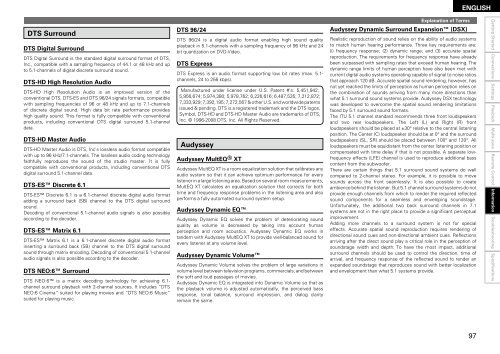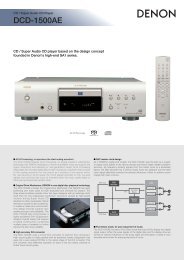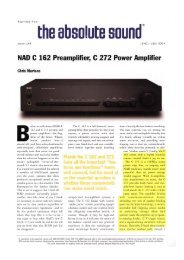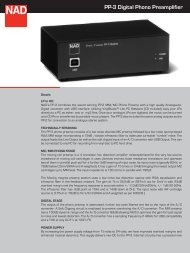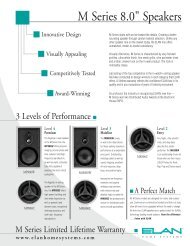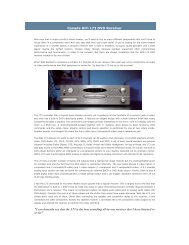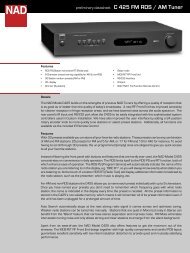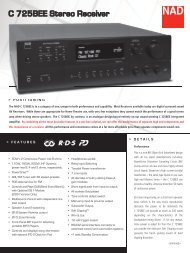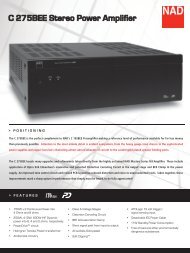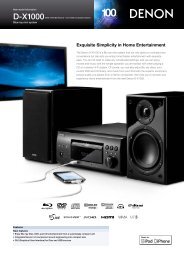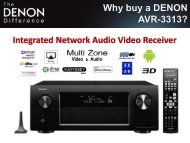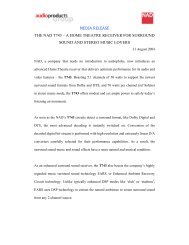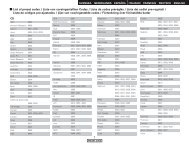Owner's Manual for AVR-4310 - Audio Products Australia
Owner's Manual for AVR-4310 - Audio Products Australia
Owner's Manual for AVR-4310 - Audio Products Australia
You also want an ePaper? Increase the reach of your titles
YUMPU automatically turns print PDFs into web optimized ePapers that Google loves.
DTS Surround<br />
DTS Digital Surround<br />
DTS Digital Surround is the standard digital surround <strong>for</strong>mat of DTS,<br />
Inc., compatible with a sampling frequency of 44.1 or 48 kHz and up<br />
to 5.1-channels of digital discrete surround sound.<br />
DTS-HD High Resolution <strong>Audio</strong><br />
DTS-HD High Resolution <strong>Audio</strong> is an improved version of the<br />
conventional DTS, DTS-ES and DTS 96/24 signals <strong>for</strong>mats, compatible<br />
with sampling frequencies of 96 or 48 kHz and up to 7.1-channels<br />
of discrete digital sound. High data bit rate per<strong>for</strong>mance provides<br />
high quality sound. This <strong>for</strong>mat is fully compatible with conventional<br />
products, including conventional DTS digital surround 5.1-channel<br />
data.<br />
DTS-HD Master <strong>Audio</strong><br />
DTS-HD Master <strong>Audio</strong> is DTS, Inc’s lossless audio <strong>for</strong>mat compatible<br />
with up to 96 kHz/7.1-channels. The lossless audio coding technology<br />
faithfully reproduces the sound of the studio master. It is fully<br />
compatible with conventional products, including conventional DTS<br />
digital surround 5.1-channel data.<br />
DTS-ES Discrete 6.1<br />
DTS-ES Discrete 6.1 is a 6.1-channel discrete digital audio <strong>for</strong>mat<br />
adding a surround back (SB) channel to the DTS digital surround<br />
sound.<br />
Decoding of conventional 5.1-channel audio signals is also possible<br />
according to the decoder.<br />
DTS-ES Matrix 6.1<br />
DTS-ES Matrix 6.1 is a 6.1-channel discrete digital audio <strong>for</strong>mat<br />
inserting a surround back (SB) channel to the DTS digital surround<br />
sound through matrix encoding. Decoding of conventional 5.1-channel<br />
audio signals is also possible according to the decoder.<br />
DTS NEO:6 Surround<br />
DTS NEO:6 is a matrix decoding technology <strong>for</strong> achieving 6.1-<br />
channel surround playback with 2-channel sources. It includes “DTS<br />
NEO:6 Cinema” suited <strong>for</strong> playing movies and “DTS NEO:6 Music”<br />
suited <strong>for</strong> playing music.<br />
DTS 96/24<br />
DTS 96/24 is a digital audio <strong>for</strong>mat enabling high sound quality<br />
playback in 5.1-channels with a sampling frequency of 96 kHz and 24<br />
bit quantization on DVD-Video.<br />
DTS Express<br />
DTS Express is an audio <strong>for</strong>mat supporting low bit rates (max. 5.1channels,<br />
24 to 256 kbps).<br />
Manufactured under license under U.S. Patent #’s: 5,451,942;<br />
5,956,674; 5,974,380; 5,978,762; 6,226,616; 6,487,535; 7,212,872;<br />
7,333,929; 7,392,195; 7,272,567 & other U.S. and worldwide patents<br />
issued & pending. DTS is a registered trademark and the DTS logos,<br />
Symbol, DTS-HD and DTS-HD Master <strong>Audio</strong> are trademarks of DTS,<br />
Inc. © 1996-2008 DTS, Inc. All Rights Reserved.<br />
Audyssey<br />
Audyssey MultEQ® XT<br />
Audyssey MultEQ XT is a room equalization solution that calibrates any<br />
audio system so that it can achieve optimum per<strong>for</strong>mance <strong>for</strong> every<br />
listener in a large listening area. Based on several room measurements,<br />
MultEQ XT calculates an equalization solution that corrects <strong>for</strong> both<br />
time and frequency response problems in the listening area and also<br />
per<strong>for</strong>ms a fully automated surround system setup.<br />
Audyssey Dynamic EQ<br />
Audyssey Dynamic EQ solves the problem of deteriorating sound<br />
quality as volume is decreased by taking into account human<br />
perception and room acoustics. Audyssey Dynamic EQ works in<br />
tandem with Audyssey MultEQ XT to provide well-balanced sound <strong>for</strong><br />
every listener at any volume level.<br />
Audyssey Dynamic Volume<br />
Audyssey Dynamic Volume solves the problem of large variations in<br />
volume level between television programs, commercials, and between<br />
the soft and loud passages of movies.<br />
Audyssey Dynamic EQ is integrated into Dynamic Volume so that as<br />
the playback volume is adjusted automatically, the perceived bass<br />
response, tonal balance, surround impression, and dialog clarity<br />
remain the same.<br />
Explanation of Terms<br />
Audyssey Dynamic Surround Expansion (DSX)<br />
ENGLISH<br />
Realistic reproduction of sound relies on the ability of audio systems<br />
to match human hearing per<strong>for</strong>mance. Three key requirements are:<br />
(i) frequency response; (2) dynamic range; and (3) accurate spatial<br />
reproduction. The requirements <strong>for</strong> frequency response have already<br />
been surpassed with sampling rates that exceed human hearing. The<br />
dynamic range limits of human perception have also been met with<br />
current digital audio systems operating capable of signal to noise ratios<br />
that approach 120 dB. Accurate spatial sound rendering, however, has<br />
not yet reached the limits of perception as human perception relies on<br />
the combination of sounds arriving from many more directions than<br />
what 5.1 surround sound systems provide. Audyssey DSX technology<br />
was developed to overcome the spatial sound rendering limitations<br />
faced by 5.1 surround sound <strong>for</strong>mats.<br />
The ITU 5.1 channel standard recommends three front loudspeakers<br />
and two rear loudspeakers. The Left (L) and Right (R) front<br />
loudspeakers should be placed at ±30° relative to the central listening<br />
position. The Center (C) loudspeaker should be at 0° and the surround<br />
loudspeakers (SL, SR) should be placed between 100° and 120°. All<br />
loudspeakers must be equidistant from the center listening position or<br />
compensated with time delay if that is not possible. A separate lowfrequency<br />
effects (LFE) channel is used to reproduce additional bass<br />
content from the subwoofer.<br />
There are certain things that 5.1 surround sound systems do well<br />
compared to 2-channel stereo. For example, it is possible to move<br />
sounds across the front seamlessly. It is also possible to create<br />
ambience behind the listener. But 5.1 channel surround systems do not<br />
provide enough channels from which to render the required reflected<br />
sound components <strong>for</strong> a seamless and enveloping soundstage.<br />
Un<strong>for</strong>tunately, the additional two back surround channels in 7.1<br />
systems are not in the right place to provide a significant perceptual<br />
improvement.<br />
Adding more channels to a surround system is not <strong>for</strong> special<br />
effects. Accurate spatial sound reproduction requires rendering of<br />
directional sound cues and non-directional ambient cues. Reflections<br />
arriving after the direct sound play a critical role in the perception of<br />
soundstage width and depth. To have the most impact, additional<br />
surround channels should be used to control the direction, time of<br />
arrival, and frequency response of the reflected sound to render an<br />
expanded soundstage that reproduces sound with better localization<br />
and envelopment than what 5.1 systems provide.<br />
Getting Started Connections Settings Playback Multi-zone Remote Control In<strong>for</strong>mation Troubleshooting Specifications


